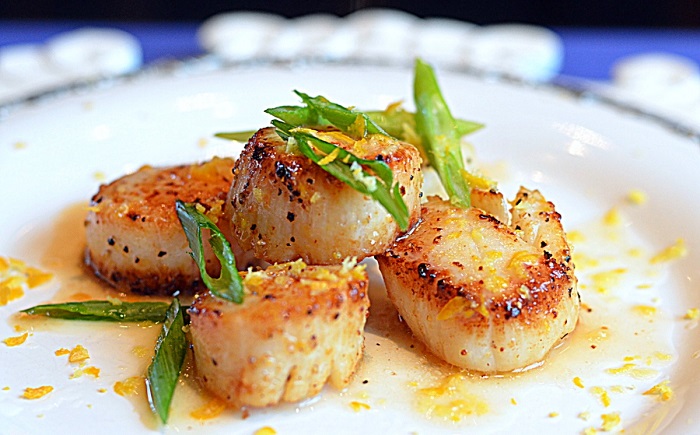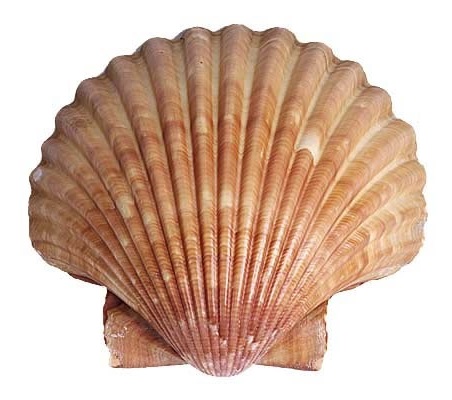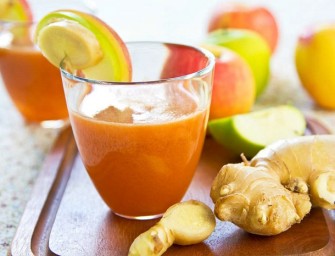Main Name: Scallops
Biological Name: Pectinidae
Biological Name: Pectinidae
Names in other languages: Peigne(French), Venera (Spanish)
With the increased supply of seafood all over the world, more people are discovering their health benefits and including them in their regular diets. Most of these foods are low in calories and fat but there are some fish which are rich in omega-3 fatty acids and a strong fishy odour. Keeping fish aside, one sea animal with a multitude of numerous essential nutrients, called the scallops, are present. They are molluscs belonging to the Pectinidae family and characterized by brightly coloured and fan-shaped shells, similar to oysters and clams. But it is their white fleshy meat that is known for its delicately sweet taste and nutritious components. Found in both bay waters and deep seas, scallops have two types of meat in one shell: the adductor muscle, also called ‘scallop’, is white and meaty and the roe, also called ‘coral’, is red or white and soft. The bay scallop is much smaller than the sea scallop with the edible portion being just half an inch as compared to the latter which provides two inches of meat. Most of the scallops are served with a mild sauce of cream cheese or butter. Look through the sections below to learn more about the history and health benefits of scallops.
History
Ever since scallops have appeared on Earth, they have been consumed and revered for their delicious taste and marvellous health benefits. But their earliest mention dates back to 1280AD, when Marco Polo found them being sold as one of the seafood in the market of Hangchow, China. However, the word ‘scallop’ is a derivation of the old French term ‘escalope’ which means ‘shell’, thereby symbolizing a shell that houses the scallop. Scallops came into the limelight during the medieval era when pilgrims visiting the shrine of St. James in Spain started using empty scallop shells for eating and begging. As a result, this marine creature became associated with the shrine. People then began nicknaming scallops as the shell of St. James, better known by their French name of Coquille St. Jacques. Gradually, with the advent of new equipment, harvesting of deepwater scallops began that lead to its spread and popularity around the world. While bay scallops are found on the East Coast of the United States in the Atlantic Ocean, sea scallops are concentrated around the West Coast in the Pacific Ocean. These water invertebrates are found in abundance in the Mediterranean Sea.
Ever since scallops have appeared on Earth, they have been consumed and revered for their delicious taste and marvellous health benefits. But their earliest mention dates back to 1280AD, when Marco Polo found them being sold as one of the seafood in the market of Hangchow, China. However, the word ‘scallop’ is a derivation of the old French term ‘escalope’ which means ‘shell’, thereby symbolizing a shell that houses the scallop. Scallops came into the limelight during the medieval era when pilgrims visiting the shrine of St. James in Spain started using empty scallop shells for eating and begging. As a result, this marine creature became associated with the shrine. People then began nicknaming scallops as the shell of St. James, better known by their French name of Coquille St. Jacques. Gradually, with the advent of new equipment, harvesting of deepwater scallops began that lead to its spread and popularity around the world. While bay scallops are found on the East Coast of the United States in the Atlantic Ocean, sea scallops are concentrated around the West Coast in the Pacific Ocean. These water invertebrates are found in abundance in the Mediterranean Sea.

http://www.allyskitchen.com/meyer-lemon-pan-grilled-scallops/
Health Benefits of Scallops
- Our body requires the amino acid, tryptophan, which is converted into serotonin that acts as a brain neurotransmitter and significant for inducing sleep. Scallops are a rich source of these proteins.
- Rich in omega-3 fatty acids, in combination with potassium and magnesium, are present in scallops and prove to be a heart-friendly food as they lower triglyceride levels and reduce the risk of blood clots, which can cause heart attacks or strokes.
- Including scallops to your diet helps you lose weight, by stimulating the rates of metabolism. To make the most of this benefit, do not consume scallops in the fried form or covered with a rich sauce.
- Vitamin B12 is significant for healthy nerve functioning. Scallops contain this nutrient in abundance and thus, reduce the risk of neurological problems and Alzheimer’s disease.
- Scallops are a powerhouse of omega-3 fatty acids, which is important for promoting cardiovascular health, easing the symptoms of premenstrual syndrome, preventing arthritis, combating skin disorders and delaying the growth of cancerous tumours.
- The presence of vitamin B12 in scallops protects the cells of the colon from cancer-causing chemicals. This plays a role in fighting against the three types of cancer – leukemia, multiple myeloma and non-Hodgkin’s lymphoma. People who consume foods, like scallops, have reduced risks of colorectal cancer too.
- Scallops intake improves the electrical properties of heart cells, thus providing protection against fatal abnormal heart rhythms.
- Studies indicate that including scallops in your diet, thrice a month, battles against ischemic stroke, a stroke caused due to the lack of blood supply to the brain.
- Research shows that consuming broiled or baked scallops reduces the risk of atrial fibrillation, the most common type of heart arrhythmia.
- Scallops have proven to lower the risk of deep vein thrombosis (DVT), a dangerous condition wherein blood clots occur in the veins of legs, thighs or pelvis, resulting in severe pain or swelling.
- Scallops have anti-inflammatory properties that reduce the production of pro-inflammatory cytokines, which are believed to enhance the symptoms of depression and stress.
Scallops Nutrition FactsAmount: 1
Total Weight: 55 g
Total Weight: 55 g
| Nutrients | Amount |
| Basic Components | |
| Proteins | 6.6 g |
| Water | 40.2 g |
| Ash | 1.7 g |
| Cholesterol | 13 mg |
| Carbohydrates | 1.7 g |
| Calories | |
| Total Calories | 38 |
| Calories From Carbohydrate | 7.2 |
| Calories From Fat | 2.4 |
| Calories From Protein | 28 |
| Fats & Fatty Acids | |
| Total Fat | 270 mg |
| Saturated Fat | 70 mg |
| Monounsaturated Fat | 26 mg |
| Polyunsaturated Fat | 72 mg |
| Omega-3 Fatty Acids | 60 mg |
| Omega-6 Fatty Acids | 4.4 mg |
| Vitamins | |
| Vitamin A | 1.7 IU |
| Vitamin E | 0.8 mg |
| Vitamin K | 0.1 mcg |
| Thiamin | 3.9 mcg |
| Riboflavin | 8.2 mcg |
| Niacin | 387 mcg |
| Vitamin B6 | 40 mcg |
| Folate | 8.8 mcg |
| Vitamin B12 | 0.78 mcg |
| Pantothenic Acid | 118 mcg |
| Choline | 44.6 mg |
| Minerals | |
| Calcium | 3.3 mg |
| Iron | 209 mcg |
| Magnesium | 12 mg |
| Phosphorus | 184 mg |
| Potassium | 113 mg |
| Sodium | 216 mg |
| Zinc | 501 mcg |
| Copper | 13 mcg |
| Manganese | 9.4 mcg |
| Selenium | 7 mcg |

http://www.furniturelibrary.com/the-sea-shell-design-motif/
How many calories in scallops (per 100 gm)
Scallops have about 69 calories per 100 gm of weight.How to Buy Scallops
Scallops have about 69 calories per 100 gm of weight.How to Buy Scallops
- Scallops are sold pre-shucked from the shell, as they cannot survive outside water. To keep them alive, they must be kept in water all along.
- Select scallops that are not pure white in colour. Stark white scallops are in indication of these molluscs being submerged in water to increase their weight, thereby giving you the meat with fewer nutrients.
- Fresh scallops vary in colour from pale beige to creamy pink with a moist sheen. The food item must smell fresh and clean.
- You can also buy frozen scallops. Make sure that the meat is solid and shiny, with the packaging being free from frost.
Scallops Storage Tips
- Cover and refrigerate fresh scallops immediately after you purchase them. Consume within a day or two, these invertebrates are highly perishable.
- You can freeze the scallops to extend their shelf life. For this, poach them in their own stock and double wrap them in a plastic bag, after which, you can place them in cold storage for up to 3 months.





